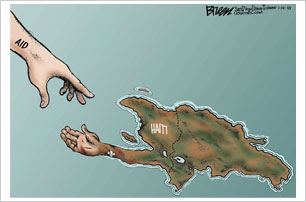
Bank ShotYes, the bank tax is unfair. But so was the bailout.
Posted Thursday, Jan. 14, 2010, at 6:43 PM ET When defending the Wall Street bailouts, President Obama typically asked Americans to tolerate a certain amount of unfairness. Now, in proposing a tax on the largest financial institutions, he's asking bankers to do the same.
When defending the Wall Street bailouts, President Obama typically asked Americans to tolerate a certain amount of unfairness. Now, in proposing a tax on the largest financial institutions, he's asking bankers to do the same.
The bank tax—or, if that's too easy to say, the Financial Crisis Responsibility Fee—would impose a 0.15 percent tax on financial institutions with more than $50 billion in assets (excluding capital reserves and deposits). The tax would fall on about 50 firms and would reap an estimated $90 billion to $117 billion over 10 years—roughly the amount of TARP money that hasn't yet been recouped.
So it's efficient. But is it fair? In a word: no. Almost all the banks targeted by the tax have paid back the money they owed. Some of them paid back even more. Goldman Sachs, for example, repaid its money with a 23 percent return to taxpayers. Indeed, the part of TARP that went to banks is not the part that has lost money. That would be the billions in loans to the auto industry, AIG, and smaller banks across the country, as well as to mortgage foreclosure mitigation efforts. The big banks, by contrast, have been responsible debtors. (After the crisis started, that is.) Why target them?
For starters, because they helped cause the crisis in the first place—an original sin that somewhat devalues the collective cry of Wall Street. Second, because the bailout is a lot more than just TARP. If the bailout consisted of merely the $700 billion lent to financial institutions, the banks might have a stronger case. But the bailout was more than that: It was the FDIC guaranteeing bank debt. It was the government rescue of money-market funds. It was the Federal Reserve restarting the securitization market. It was the backstop of the commercial paper program. Taxpayers assumed a huge amount of risk through these programs, and the banks profited. Third, because this is how TARP was supposed to work: The legislation that created it, the Emergency Economic Stabilization Act, stipulates that the financial industry has to pay back all the money it owes. It just didn't specify how.
And that's where the unfairness comes in. Nowhere does the legislation say that the 50 biggest firms have to pay back the loans. That responsibility could have fallen to any number of financial institutions. It was the Obama administration's idea to focus on the big guys—a decision that's hard to explain entirely in nonpolitical terms.
Sure, there is a policy explanation. Taxing the biggest banks discourages them from becoming "too big to fail." How much it discourages them is up for debate. Is a 0.15 percent tax going to dissuade two $25 billion investment firms from merging? Who knows. Another benefit: taxing nondepository assets encourages large banks to do more traditional lending—i.e., lending that is actually based on the amount of insured deposits they have—which they've been hesitant to do after getting bailed out. But that doesn't explain why smaller institutions aren't at least asked to help.
What explains that decision is politics. "People tend to think of smaller banks like Jimmy Stewart in It's a Wonderful Life," says Doug Elliot, a former investment banker at JPMorgan who now works at the Brookings Institution. "They have a much better political standing." They're also in every congressional district, as opposed to the big banks, which are headquartered mainly in New York.
Bankers also say that any tax on them will get passed onto the consumer. But that doesn't really bother supporters of the tax. "If Bank of America wants to pass its cost on to consumers, that's fine," says David Min of the Center for American Progress. "I'll just go over to my regional bank." Another objection from the financial industry is that the tax will reduce the amount they can lend. Again, says Min, no worries. If banks do lend less, they will be less likely to become "too big to fail." Plus, they can always start doing less securitization and more depository lending, which is considered safer and isn't affected by the tax.
Going after the big banks and leaving the little guys alone may be a crass populist move. Obama's poll numbers are lower than they've ever been. Anger over the executive bonuses still rages. And banking executives are defending their practices before Congress this week with no signs of penitence.
But it's also a course correction. Last time, big banks profited from their own failures on the backs of taxpayers. This time, taxpayers will recoup the money they lost on the backs of the big banks. Two wrongs don't make a right. But they do make it even.
 Why Jon Stewart Failed To Make John Yoo Squirm
Why Jon Stewart Failed To Make John Yoo Squirm The New Season of 24 Gets Everything Wrong About New York
The New Season of 24 Gets Everything Wrong About New York How a Scott Brown Senate Win in Massachusetts Could Sink Health Care Reform
How a Scott Brown Senate Win in Massachusetts Could Sink Health Care Reform Attention, Slate Readers in Washington, D.C.: Join Us for a Discussion About Google and China
Attention, Slate Readers in Washington, D.C.: Join Us for a Discussion About Google and China Is Gawker's "Apple Tablet Scavenger Hunt" Illegal?
Is Gawker's "Apple Tablet Scavenger Hunt" Illegal? The Banking Industry Has Been Wrong About Regulation Since 1797
The Banking Industry Has Been Wrong About Regulation Since 1797












"Goldman Sachs, for example, repaid its money with a 23 percent return to taxpayers."
Of course, Goldman was able to do that because the money the feds gave to AIG was used to pay Goldman 100 cents on the dollar. The money given to AIG hasn't and probably won't ever be repaid.
-- smslaw
(To reply, click here)
Unfair! Unfair! Huh? Every tax we've ever had benefits some group or other and penalizes somebody else. Why do I have to pay taxes for your kid's school? Why does some of your gas tax money build a light rail for me to ride? We could offer a rebate to the big financials that paid back TARP money, but they should still pay something. After all, they still exist because the taxpayers rescued them.
-- Arlington
(To reply, click here)
This tax is not a tax on assets, it's a tax on debt and leverage. Here's the calculation:
Capital=equity
Liabilities = deposits + debt (simplified, but true)
Assets = liabilities + equity
Assets - deposits - equity = debt
The problem with too big to fail is that debt financing becomes much, much cheaper because of the implicit guarantee from the US govt, a guarantee that is worth between .5 and .75%. So this tax is simply recouping a part of the economic rent extracted by these institutions. THIS IS FREE INSURANCE FROM TAXPAYERS. I would suggest that it is fair and that it doesn't go far enough. You get it all wrong.
-- lemarin
(To reply, click here)